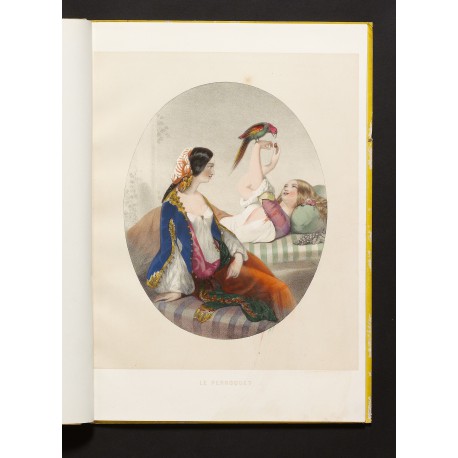
Le Sérail illustré par Auguste Bouvier Lithographie par Régnier & Bettannier
- Subjects
- Book illustration - Artists, British - Bouvier (Augustus Jules), c. 1825-1881
- Turkey - Court and courtiers
- Authors/Creators
- Bouvier, Augustus Jules, c. 1825-1881
- Artists/Illustrators
- Bettannier, Joseph (?), 1803-1887
- Bouvier, Augustus Jules, c. 1825-1881
- Printers/Publishers
- Barbe, Charles, active 1846-1848
- Gache, Henri, active 1846-1848
- Lemercier [Joseph, 1803-1887?], active 1846-1855
Bouvier, Augustus Jules
London c.1825 – 1881
Le Sérail illustré par Auguste Bouvier Lithographie par Régnier & Bettannier.
Paris & London, ‘H[enri]. Gache éditeur, 58 rue de la Victoire; London, pub. by C. Barbe, 60, Regent’s quadrant’ (‘Imp. [Joseph] Lemercier a Paris’), [no date; circa 1846–1848]
folio (390 × 275 mm), (12) ff., a group of twelve tinted lithographs (toned areas circa 350 × 255 mm).
contents twelve numbered lithographs, pairs of female figures with captions, bound in this order ■ Le Voile 3 ■ Le Chibouc 4 ■ La Musique 5 ■ Le Perroquet 6 ■ Le Langage des fleurs 12 ■ L’Écrin 11 ■ La Sultane 10 ■ Les Poissons d’Or 9 ■ La Danse 7 ■ Le Récit 8 ■ Le Miroir 1; and a plate (probably misbound from another work, captioned) ■ Bleuettes 9 (publication line: Paris, H. Gache rue de la Victoire, 66 | Imp. Lemercier, r. de Seine 57, Paris).
binding publisher’s yellow boards (title and imprint transcribed above are printed on upper cover).
A rare series of prints depicting women in the harem, loosely draped, drawn by the English artist Augustus Jules Bouvier, while he was a student in Paris. The prints were first issued individually (or in pairs) in 1845 or 1846; this collected edition under the title Le Sérail illustré seems to be unknown. Three of the more prurient images were featured in a recent survey of orientalist works about the harem.1

Augustus Jules was the son of the artist Jules Bouvier (1800–1867), who in 1818 had moved from Paris to London, where he married, and produced six children, all of whom became painters. Augustus Jules entered the Royal Academy Schools in 1841; he continued his studies in Paris, and perhaps also in Italy; and after returning to London, became a specialist in genre and historical scenes, first exhibiting at the Royal Academy in 1852.
The ‘dessinateurs lithographes’ of Bouvier’s designs are identified on the publisher’s binding as (Joseph and/or Édouard) Bettannier2 and (Claude) Régnier, the printer as (Joseph) Lemercier, and the distributors as Henri Gache in Paris and Camille (or Charles) Barbe in London. Impressions of the prints held by the Bibliothèque nationale de France are said to be dated 1845 and to have publication lines naming Lemercier, Henri Gache in Paris and Gambart, Junin and Co. in London.3 The prints were first registered in the Bibliographie de la France in April 1846 (six prints)4 and in May 1846 (four prints);5 a suite comprising six prints appeared the same year.6

Our collection entitled Le Sérail illustré appears to be unrecorded. Since Barbe, an importer of prints and artists’ supplies, began to trade in 1849 as Lechertier Barbe, an issue date of circa 1846–1848 is likely.
1. Joan DelPlato, Multiple wives, multiple pleasures: Representing the Harem, 1800–1875 (Madison, nj 2002), p.88: Le Voile ‘Two eastern women flirt, one using her veil… When eastern women remove their own veils, they are no longer passive victims but sexually assertive women who demonstrate that they are ready for love’ (reproduced p.88 as Fig. 3.19); p.115: Le Chibouk ‘In a prurient group of French images the tube and mouthpiece of the hookah are phallicized… The tube crosses over the leg and arm of two women, suggesting the male they share’ (reproduced p.123 as Fig. 4.19); p.136: La Musique ‘A more playful rendering of the servant making music to arouse the female occurs in La Musique… in which loose hair and déshabillé distinguish the affected listener from the musician’ (reproduced p.143 as Fig. 4.44).
2. Bibliothèque Nationale, Inventaire du fonds français après 1800 (Paris 1937), ii, pp.374–392 (Bettanier).
3. Beatrice Farwell, French Popular Lithographic Imagery, 1815–1870. Volume 11. Pinups and erotica (Chicago 1995), p.46, recording five of the twelve prints only: Le Voile (2E2), Le Chibouc (2D12), La Musique (2D9), Le Perroquet (2D11), and Le Miroir (2D10). Farwell also lists a print entitled Le Bain (2E1), which we suppose to be the plate substituted here by Bleuettes 9 (see contents above).
4. Bibliographie de la France, 11 April 1846, p.183 no. 311: ■ ‘La Sultane, par Régnier et Bettannier, d’après Bouvier’ ■ ‘Les Poissons d’or, par id., d’après idem: deux odalisques. – A Paris, chez Lemercier’ and no. 313: ■ ‘Le Récit, par Régnier et Bettannier, d’après Bouvier: deux odalisques causant’ ■ ‘Le Langage des fleurs, par idem, d’après idem’ ■ ‘La Danse, par idem, d’après idem: deux odalisques dansant’ ■ ‘L’Ecrin, 4, par idem, d’après idem: deux odalisques regardant des bijoux’.
5. Bibliographie de la France, 23 May 1846, p.257 no. 473: ‘Le sérail, 2. – [■] Le perroquet, [■] le voile, 2 sujets sur la même feuille. – A Paris, chez Lemercier’ and no. 475: ‘Le sérail, 1. – [■] Le chibouk, [■] la musique, 2 sujets sur la même feuille. – A Paris, chez Lemercier.’ Two prints are not found in the Bibliographie de la France: ‘Le Miroir’ and ‘Bleuettes’; the publication line on the latter print locates Henri Gache at a different address (rue de la Victoire, 66; vs. rue de la Victoire, 58).
6. Jules Gay, Iconographie des estampes à sujets galants et des portraits de femmes célèbres par leur beauté (Paris 1868), col. 116, describing ‘Scènes d’odalisques’, a ‘suite de six lithogr. par Régnier et Bettannier. Paris, Lemercier, 1846’ comprising ‘La Sultane, Les Poissons d’or, Le Récit, Le Langage des fleurs, La Danse, L’Écrin’.




